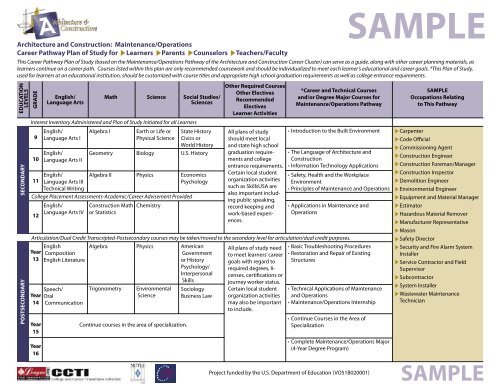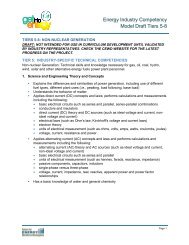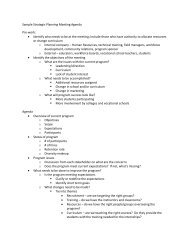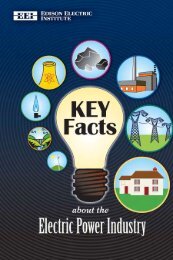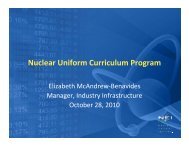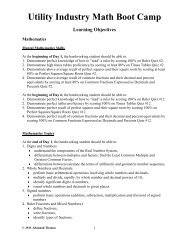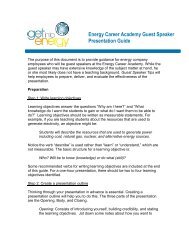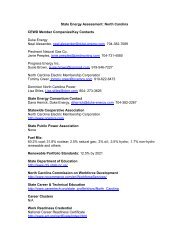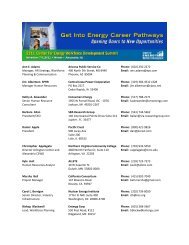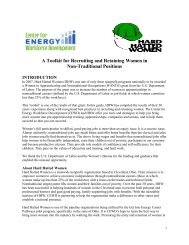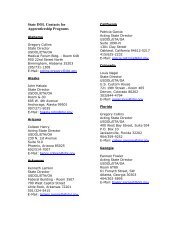Maintenance/Operations
Maintenance/Operations
Maintenance/Operations
Create successful ePaper yourself
Turn your PDF publications into a flip-book with our unique Google optimized e-Paper software.
Architecture and Construction: <strong>Maintenance</strong>/<strong>Operations</strong><br />
Career Pathway Plan of Study for Learners Parents Counselors Teachers/Faculty<br />
SAMPLE<br />
This Career Pathway Plan of Study (based on the <strong>Maintenance</strong>/<strong>Operations</strong> Pathway of the Architecture and Construction Career Cluster) can serve as a guide, along with other career planning materials, as<br />
learners continue on a career path. Courses listed within this plan are only recommended coursework and should be individualized to meet each learner’s educational and career goals. *This Plan of Study,<br />
used for learners at an educational institution, should be customized with course titles and appropriate high school graduation requirements as well as college entrance requirements.<br />
EDUCATION<br />
LEVELS<br />
SECONDARY<br />
POSTSECONDARY<br />
GRADE<br />
Interest Inventory Administered and Plan of Study Initiated for all Learners<br />
9<br />
10<br />
11<br />
Algebra I<br />
Geometry<br />
Algebra II<br />
Construction Math<br />
or Statistics<br />
Algebra<br />
Math Science Social Studies/<br />
Sciences<br />
College Placement Assessments-Academic/Career Advisement Provided<br />
12<br />
Year<br />
13<br />
Year<br />
14<br />
Year<br />
15<br />
English/<br />
Language Arts<br />
English/<br />
Language Arts I<br />
English/<br />
Language Arts II<br />
English/<br />
Language Arts III<br />
Technical Writing<br />
English/<br />
Language Arts IV<br />
English<br />
Composition<br />
English Literature<br />
Speech/<br />
Oral<br />
Communication<br />
Trigonometry<br />
Earth or Life or<br />
Physical Science<br />
Biology<br />
Physics<br />
Chemistry<br />
Physics<br />
Environmental<br />
Science<br />
Continue courses in the area of specialization.<br />
State History<br />
Civics or<br />
World History<br />
U.S. History<br />
Economics<br />
Psychology<br />
American<br />
Government<br />
or History<br />
Psychology/<br />
Interpersonal<br />
Skills<br />
Sociology<br />
Business Law<br />
Other Required Courses<br />
Other Electives<br />
Recommended<br />
Electives<br />
Learner Activities<br />
All plans of study<br />
should meet local<br />
and state high school<br />
graduation requirements<br />
and college<br />
entrance requirements.<br />
Certain local student<br />
organization activities<br />
such as SkillsUSA are<br />
also important including<br />
public speaking,<br />
record keeping and<br />
work-based experiences.<br />
*Career and Technical Courses<br />
and/or Degree Major Courses for<br />
<strong>Maintenance</strong>/<strong>Operations</strong> Pathway<br />
• Introduction to the Built Environment<br />
• The Language of Architecture and<br />
Construction<br />
• Information Technology Applications<br />
• Safety, Health and the Workplace<br />
Environment<br />
• Principles of <strong>Maintenance</strong> and <strong>Operations</strong><br />
• Applications in <strong>Maintenance</strong> and<br />
<strong>Operations</strong><br />
Articulation/Dual Credit Transcripted-Postsecondary courses may be taken/moved to the secondary level for articulation/dual credit purposes.<br />
All plans of study need<br />
to meet learners’ career<br />
goals with regard to<br />
required degrees, licenses,<br />
certifications or<br />
journey worker status.<br />
Certain local student<br />
organization activities<br />
may also be important<br />
to include.<br />
• Basic Troubleshooting Procedures<br />
• Restoration and Repair of Existing<br />
Structures<br />
• Technical Applications of <strong>Maintenance</strong><br />
and <strong>Operations</strong><br />
• <strong>Maintenance</strong>/<strong>Operations</strong> Internship<br />
• Continue Courses in the Area of<br />
Specialization<br />
Carpenter<br />
Code Official<br />
Commissioning Agent<br />
Construction Engineer<br />
Construction Foreman/Manager<br />
Construction Inspector<br />
Demolition Engineer<br />
Environmental Engineer<br />
Equipment and Material Manager<br />
Estimator<br />
Hazardous Material Remover<br />
Manufacturer Representative<br />
Mason<br />
SAMPLE<br />
Occupations Relating<br />
to This Pathway<br />
Safety Director<br />
Security and Fire Alarm System<br />
Installer<br />
Service Contractor and Field<br />
Supervisor<br />
Subcontractor<br />
System Installer<br />
Wastewater <strong>Maintenance</strong><br />
Technician<br />
Year<br />
16<br />
• Complete <strong>Maintenance</strong>/<strong>Operations</strong> Major<br />
(4-Year Degree Program)<br />
Project funded by the U.S. Department of Education (VO51B020001)<br />
SAMPLE
Architecture and Construction—<strong>Maintenance</strong>/<strong>Operations</strong><br />
Architecture and Construction: <strong>Maintenance</strong>/<strong>Operations</strong><br />
Tips for Creating a Career Pathway Plan of Study for Instructional Leaders Administrators Counselors Teachers/Faculty<br />
SAMPLE<br />
Creating Your Institution’s Own Instructional Plan of Study<br />
With a team of partners (secondary/postsecondary teachers and faculty, counselors, business/industry representatives, instructional leaders,<br />
and administrators), use the following steps to develop your own scope and sequence of career and technical courses as well as degree<br />
major courses for your institution’s plan of study.<br />
1<br />
2<br />
3<br />
4<br />
5<br />
6<br />
7<br />
Crosswalk the Cluster Foundation Knowledge and Skills (available at http://www.careerclusters.org/goto.cfm?id=83) to the<br />
content of your existing secondary and postsecondary programs/courses.<br />
Crosswalk the Pathway Knowledge and Skills (available at http://www.careerclusters.org/goto.cfm?id=10) to the content of<br />
your existing secondary/postsecondary programs and courses.<br />
Based on the crosswalks in steps 1 and 2, determine which existing programs/courses would adequately align to (cover) the<br />
knowledge and skills. These programs/courses would be revised to tighten up any alignment weaknesses and would become a<br />
part of a sequence of courses to address this pathway.<br />
Based on the crosswalks in steps 1 and 2, determine what new courses need to be added to address any alignment weaknesses.<br />
Sequence the content and learner outcomes of the existing programs/courses identified in step 3 and new courses identified in<br />
step 4 into a course sequence leading to preparation for all occupations within this pathway. (See list of occupations on page 1 of<br />
this document.)<br />
The goal of this process would be a series of courses and their descriptions. The names of these courses would be inserted into<br />
the Career and Technical Courses column on the Plan of Study on page 1 of this document.<br />
Below is a sample result of steps 1-6, and these course titles are inserted into the Plan of Study on page 1 of this document.<br />
8<br />
Crosswalk your state academic standards and applicable national standards (e.g., for mathematics, science, history, language arts,<br />
etc.) to the sequence of courses formulated in step 6.<br />
SAMPLE
Architecture and Construction: <strong>Maintenance</strong>/<strong>Operations</strong><br />
SAMPLE<br />
SAMPLE Sequence of Courses for Instructional Leaders Administrators Counselors Teachers/Faculty<br />
Below are suggested courses that could result from steps 1-6 above. However, as an educational institution, course titles, descriptions and the sequence will be your own. This is a good<br />
model of courses for you to use as an example and to help you jump-start your process. Course content may be taught as concepts within other courses, or as modules or units of instruction.<br />
The following courses are based on the Cluster Foundation Knowledge and Skills found at http://www.careerclusters.org/goto.cfm?id=83. These skills are reinforced through instruction using<br />
hands-on applications and through participation in student organization activities.<br />
#1<br />
Introduction to the Built Environment: This core course for the Architecture and Construction Career Cluster will build a knowledge base and technical skills in all aspects of the industry. Learners will be exposed<br />
to a broad range of architecture and construction careers and cluster foundation knowledge and skills including basic safety, plan reading, use of tools and equipment and basic rigging as well as how<br />
to employ positive work ethics in their careers. Possible student certifications to be earned include NCCER Core, RCA Series, Basic First Aid and CPR. Participation in SkillsUSA will reinforce cluster knowledge<br />
and skills. It is recommended that a construction mathematics course be offered in conjunction with this introductory skills course. This may be taught as a career exploration course in conjunction with<br />
other foundation Career Cluster courses.<br />
#2<br />
The Language of Architecture and Construction: Students will build the skills necessary to understand what is being communicated through drawings and documents and, in turn, convey ideas, duties and<br />
tasks to others in a form representing the industry. Students will use and follow industry-specific verbal and visual skills to accomplish workplace/job-site communications. Students will exhibit public<br />
relations skills and enhance communication skills by listening to and speaking with a variety of individuals. Students will learn universal signs and symbols such as colors, flags, stakes and hand signals to<br />
function safely in the workplace.<br />
The following courses are based on the Cluster Foundation Knowledge and Skills as well as the Pathway Knowledge and Skills found at http://www.careerclusters.org/goto.cfm?id=10. These<br />
skills are reinforced through instruction using hands-on applications and through participation in student organization activities.<br />
#3<br />
Information Technology Applications: Students will use technology tools to manage personal schedules and contact information, create memos and notes, prepare simple reports and other business communications,<br />
manage computer operations and file storage, and use electronic mail, Internet applications and GIS to communicate, search for and access information. Students will develop skills related to<br />
word processing, database management and spreadsheet applications.<br />
#4<br />
Safety, Health and the Workplace Environment: Students will develop in-depth skills for maintaining a safe and productive environment including following regulations to perform inspections, participate in<br />
emergency response teams to perform emergency drills, identify unsafe conditions and take corrective actions, and provide a safety orientation to train other employees in safe practices and emergency<br />
procedures. Students will ensure that equipment is being used safely in the workplace, suggest processes and procedures to support safety in the workplace, and fulfill safety and health requirements for<br />
maintenance, installation and repair. Students will monitor equipment and operator performance to assure workplace safety and compliance with both company and national regulations.<br />
#5<br />
Principles of <strong>Maintenance</strong> and <strong>Operations</strong>: This course provides an overview of processes used in maintenance and operations occupations within the Architecture and Construction Career Cluster. Students<br />
will develop problem-solving and critical-thinking skills by identifying the relationship between available resources and requirements of a project/problem to accomplish realistic planning. Students will<br />
employ basic methods of data collection and analysis to provide potential clients with information for projects. Course content may reflect some of the knowledge and skills of the Visual Arts Pathway from<br />
the Arts, Audio/Video Technology and Communications Career Cluster found at http://www.careerclusters.org/goto.cfm?id=13.<br />
#6<br />
Applications in <strong>Maintenance</strong> and <strong>Operations</strong>: Students will develop skills that relate to commissioning maintenance and operations. Course content will include steps for managing project assignments in a<br />
timely manner and development of skills for working as individuals and as team members to accomplish assignments. Students will complete a project that utilizes the knowledge and skills learned in the<br />
<strong>Maintenance</strong> and <strong>Operations</strong> Pathway.<br />
#7<br />
Basic Troubleshooting Procedures: Students will develop skills of using basic troubleshooting procedures to solve maintenance problems. Processes learned will include isolating the maintenance problem,<br />
selecting a solution to address the maintenance problem and using the correct strategies, tools and equipment to implement the solution. Students will practice communicating with customers how they<br />
addressed strategies used to reach the solution.<br />
#8<br />
Restoration and Repair of Existing Structures: Students will apply skills to restore or repair existing structures. Students will learn evaluation strategies to assess problems and plan solutions; identify the tools,<br />
materials and human resources needed to complete the work; and complete the work to restore to the original condition.<br />
#9<br />
Technical Applications of <strong>Maintenance</strong> and <strong>Operations</strong>: Students will exhibit a positive work ethic to comply with employment requirements. This course will allow students to reinforce the previously learned<br />
knowledge and skills of the pathway including restoration procedures and practicing maintenance to service existing structures using a checklist to track preventive maintenance. Students will identify<br />
necessary tools and materials, and establish time-based schedules to perform the maintenance. Students will also maintain and use operational systems to achieve smooth operation of facilities.<br />
#10<br />
<strong>Maintenance</strong>/<strong>Operations</strong> Internship: Students will work under supervision in an area of interest that relates to maintenance and operations. Restoration of existing facilities will be included.
Notes


